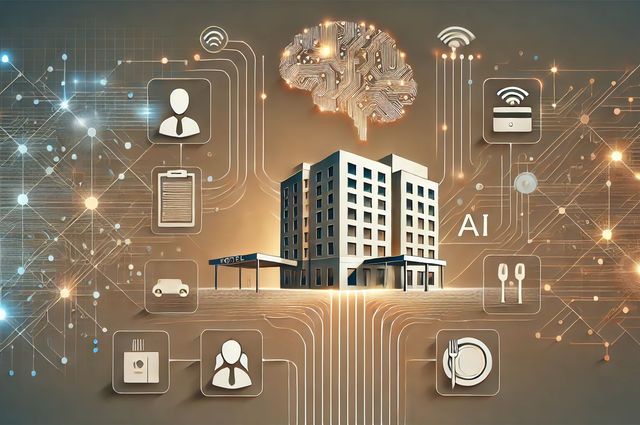What Connections are Required to Build Clean Datasets for Useful AI Actions?
8 experts shared their view
Artificial intelligence is the buzz of buzz words, but like practically everything else in the hotel technology world, it's hardly simple.
Notably, in the era of 'data is the new oil', companies are often forgetting the other caveat emptor catchphrase of, 'Garbage in, garbage out' (abbreviated as GIGO) that has been discussed in the latest HN Thematics with Shiji Group.
Because machines learn from correlation derived from massive data sets, incomplete or inaccurate databases can misinform an algorithm, produce negligible returns on the investment or, worst of all, result in jumbled personalization attempts that lead to service errors. It follows that a critical first step to having your data flow like black gold is to ensure you have the right plumbing hookups - integrations, interfaces, EDIs, APIs and so on.
And yet, there's a third classical adage that enters the picture here courtesy of Voltaire: 'Perfect is the enemy of the good enough'. In a modern sensibility, one might interpret this quote as, 'Move fast and break things'. And yet, as a cautionary tale, we are well aware of what happens when a tech company moves too fast and breaks one too many things (read: Cambridge Analytica).
There has to be an equilibrium between implementing now versus waiting for the perfect timing to do so. Hence, this balancing act between realizing the lucrative prospects of AI right now and avoiding GIGO-esque situations raises the questions: Which data connections are absolutely essential in order to build 'good enough' datasets for agentic AI to act upon? For each interface identified, why is it essential and what AI use cases can be realized from having unified, structured data amongst these systems?
HN Thematics
Single Provider for Seamless Data

This World Panel Viewpoint is sponsored by Shiji Group
More information
Building Clean Data Foundations for AI in Hospitality
You can AI your way into insanity and still end up with incorrect data points, leading to a poor customer experience. The real question is: how do you capture the correct information from the people on property?
The old idea of a single “Source of Truth” is no longer realistic. Just like a hotel pool that suddenly goes out of service for three weeks, truth can change overnight.
Accurate data ultimately depends on the employee who knows the update. Which system they use (CRS, PMS, OTA extranet, or channel manager), depends on what they have access to at the moment the change needs to be made.
What’s essential today is a single system that continuously monitors connected APIs, systems, and third parties to validate changes and catch updates to amenities, attributes, and policies.
There is really no difference between preparing data for Gen AI and for other tech tools: structured data must be normalised, deduplicated, and governed, while Gen AI is best applied to unstructured sources like reviews, transcripts, or free-text notes. The main hospitality systems - PMS, POS, Spa, RMS, CRS, CRM etc - have been built on normalized databases and deterministic (rules-driven) processes. Throw that away at your peril.
Despite the hype, LLMs remain next-best-word probability engines without a world model. They fundamentally don't understand before/after, checked in/out, paid/due, etc, so they stumble on core hospitality logic such as dates (9/11 vs 11/9 anyone?), revenue recognition (you can't bank money until a service has been delivered), or duplicate guest profiles. These issues are still better handled through proper integrations, middleware, RPA, and human oversight.
Agentic AI is the new uber-hype, but it is essentially an LLM on top of other LLMs orchestrating process flows. Fine for simple cases, but brittle when exceptions arise. Gen AI has value as a layer on top, extracting sentiment or patterns from messy text, but clean, structured data and strong governance remain the foundation. There are no shortcuts.
Related article by Fergus Boyd
AI in hospitality cannot be reduced to a fixed list of use cases, because the technology and its applications evolve too quickly and vary too widely across companies. Each organisation runs on its own mix of operations, tech stacks, data flows, and structures, which means their AI opportunities will always be unique to their context and business challenges. Rather than chasing a universal recipe or static set of examples, the real task is to build flexible, well-connected, and clean data foundations that allow use cases to emerge and adapt as both technology and needs evolve. In the end, AI is less about narrowing possibilities than about creating the right conditions for each company’s own pathways to develop.
GIGO has been repeated so often in AI debates that it has ossified into a mantra stripped of meaning. Of course, if you feed garbage into a machine, you will not get revelation out of it. But these systems are not Xerox copiers of error, they are probability engines trained to weave coherence out of chaos. Sometimes they repair the nonsense, sometimes they fail, and sometimes they fabricate entire hallucinations.
The real danger, in my view, is not GIGO but GIHO (“garbage in, hallucination out”). Because garbage still looks like garbage, but a hallucination looks persuasive, and that is far more strategically dangerous. This becomes particularly problematic in hospitality, where our tech stack is heavily siloed.
And the ugliest silos are not even technical, but human. I once watched a revenue manager deliberately sabotage his own data pipeline so the RMS would fail. He knew, correctly, that the machine was coming for his job...
So, the question is not only which data connections are essential, but also what kind of (human) trust, governance, and training are required to get there.
Because if you have a technoluddite in your team, the risk of sabotage is very real...
I believe priority #1 for independent hoteliers, midsize and smaller hotel brands is to create true two-way APIs among three crucial technology pieces: PMS-CRS-CRM. This is the only way to prepare the property for the agentic AI, expected to take over hotel bookings, guest relationships and personalization over the next years.Where do hoteliers start? Implement a CRM technology to aggregate all of the property’s first-party and zero-party data, which is then cleansed, de-duped, enriched and appended. If you already have CRM in place, consider upgrading to a CDP to empower property operations, customer service and personalization.First-party data is all of your guest data, opt-in email subscribers, lists of corporate travel managers, meeting planners and group leaders that comes from the PMS, CRS, WBE, etc. First-party and zero-party guest data have become more precious than gold today due to government privacy regulations as well as browsers and search engines own privacy protections.The more you know about your guests, their preferences, their likes and dislikes, their past stay history, and their RFM value (Recency, Frequency, and Monetary), the better you can deliver value, recognition, and personalized service. AI can make this process a thousand times more efficient and effective.
Related article by Max Starkov
In hospitality, the industry's legacy of poor data architecture and lack of discipline in maintaining data quality has left many businesses "behind the eightball". While data is the "new oil," it has not been given the respect it deserves. My experience, honed over a decade of deploying enterprise-level customer data consolidation for luxury brands, confirms that a "single source of truth" is a necessary objective.The process is not about shortcuts; it begins with the standardization of data and the rollout of those standards, followed by cleanup. Only after this foundational layer is in place is true consolidation a reality. Without this alignment, the effort inevitably "falls apart," and staff are "literally speaking a different language".Such an approach is essential because failure is not a viable option. Technology can help with "heavy lifting," but it is not a magic bullet. The path to realizing the full value of data begins with a commitment to fundamental principles. The "now" is to undertake this journey, augmenting information business function by business function to a master data set, which provides the essential inputs for AI to move beyond simple automation and deliver on its true promise of personalized service and strategic insight.
Related article by Mark Fancourt
The reality is that AI’s value in hospitality is unlocked not by hype, but by the quality and connectivity of our data - all stakeholders need to align better on this topic. For hotels, the essential integrations are PMS, RMS, POS, CRM, and channel managers—these must be capable of real-time, bi-directional data flow to avoid the “garbage in, garbage out” trap. Structured, unified data across these systems enables AI to deliver on its promise: predictive personalisation, dynamic pricing, and operational automation that genuinely drive guest satisfaction and profitability.
Yet, the pursuit of perfection can stall progress, as well as suppliers' continuous "unwillingness" to partner for the better of the industry and its guests. We must champion vendor-neutral, flexible and open interfaces that allow for incremental improvement rather than waiting for mythical standards. Ultimately, it is not about replacing the human element, but empowering teams to act faster and smarter. The future belongs to operators who invest in clean, actionable data foundations today and embrace a culture of continuous improvement. AI, when layered atop robust data plumbing, becomes not just a tool, but a catalyst for genuine transformation in hospitality.
Everyone wants the hotel tech stack to be more guest-centric and hopes AI will help to deliver a more personalized experience. This future will be centered around the PMS as the hub for rooms-centric operations and the CRM/CDP for repeat-visit-oriented relationships with guests.A strong connection between these two systems is vital to have the CRM/CDP ingest the most information about guests so that ML has big and accurate data sets by which to recommend segments, retool rates, create suggested packages, A/B upselling offers and so on.But both of these systems are back-of-house. The guest doesn't interact with a PMS or CRM; they look at booking engines, newsletters, websites, chat widgets or apps. So, it's one thing to have a centralized pool of guest profile information as training data; it's a step above to get feedback on that data by serving different offers across the entire guest journey.This need for powerful, AI-ready guest-facing systems implies that you also need a well-interfaced GEMS with a unified, omnichannel inbox that can handle automated personalization across email, text and voice. Start with those three, possibly using middleware to get the interfaces set up.

This World Panel Viewpoint is sponsored by Shiji Group
More information








